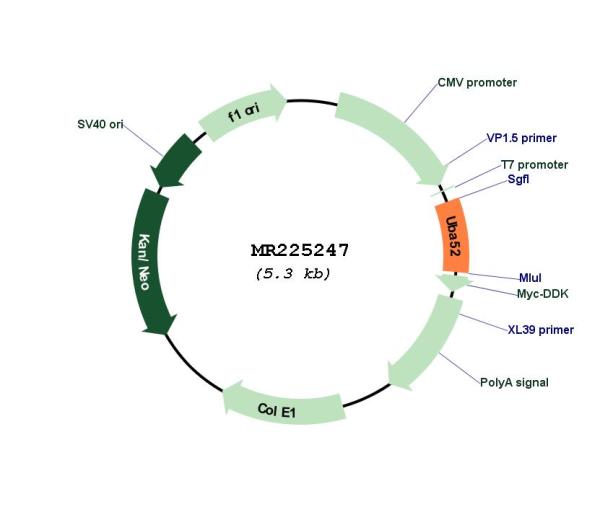Uba52 (NM_019883) Mouse Tagged ORF Clone
CAT#: MR225247
- TrueORF®
Uba52 (Myc-DDK-tagged) - Mouse ubiquitin A-52 residue ribosomal protein fusion product 1 (Uba52)
ORF Plasmid: tGFP
"NM_019883" in other vectors (4)
Need custom modification / cloning service?
Get a free quote
CNY 1,200.00
CNY 3,705.00
CNY 300.00
Specifications
| Product Data | |
| Type | Mouse Tagged ORF Clone |
| Tag | Myc-DDK |
| Synonyms | Cep52; D8Ertd21e; Gm1863; Rps27a; Ubb; Ubc |
| Vector | pCMV6-Entry |
| E. coli Selection | Kanamycin (25 ug/mL) |
| Mammalian Cell Selection | Neomycin |
| Sequence Data |
>MR225247 ORF sequence
Red=Cloning site Blue=ORF Green=Tags(s) TTTTGTAATACGACTCACTATAGGGCGGCCGGGAATTCGTCGACTGGATCCGGTACCGAGGAGATCTGCC GCCGCGATCGCC ATGCAGATCTTCGTGAAGACCCTGACGGGCAAGACCATCACTCTTGAGGTCGAGCCCAGTGACACCATCG AGAATGTCAAGGCCAAGATCCAAGACAAGGAAGGCATCCCACCTGACCAGCAGAGGCTGATATTCGCGGG CAAACAGCTGGAGGATGGCCGCACCCTGTCCGACTACAACATCCAGAAAGAGTCCACCTTGCACCTGGTG CTGCGTCTGCGCGGTGGCATCATTGAGCCATCCCTTCGTCAGCTTGCCCAGAAGTACAACTGTGACAAGA TGATCTGCCGCAAGTGCTACGCACGCCTGCACCCTCGTGCAGTCAACTGCCGCAAGAAGAAGTGCGGCCA TACCAACAACCTGCGCCCCAAGAAGAAGGTCAAA ACGCGTACGCGGCCGCTCGAGCAGAAACTCATCTCAGAAGAGGATCTGGCAGCAAATGATATCCTGGATT ACAAGGATGACGACGATAAGGTTTAA >MR225247 protein sequence
Red=Cloning site Green=Tags(s) MQIFVKTLTGKTITLEVEPSDTIENVKAKIQDKEGIPPDQQRLIFAGKQLEDGRTLSDYNIQKESTLHLV LRLRGGIIEPSLRQLAQKYNCDKMICRKCYARLHPRAVNCRKKKCGHTNNLRPKKKVK TRTRPLEQKLISEEDLAANDILDYKDDDDKV |
| Restriction Sites |
SgfI-MluI
Cloning Scheme for this gene
Plasmid Map

|
| ACCN | NM_019883 |
| ORF Size | 387 bp |
| OTI Disclaimer | The molecular sequence of this clone aligns with the gene accession number as a point of reference only. However, individual transcript sequences of the same gene can differ through naturally occurring variations (e.g. polymorphisms), each with its own valid existence. This clone is substantially in agreement with the reference, but a complete review of all prevailing variants is recommended prior to use. More info |
| OTI Annotation | This clone was engineered to express the complete ORF with an expression tag. Expression varies depending on the nature of the gene. |
| Product Components | The ORF clone is ion-exchange column purified and shipped in a 2D barcoded Matrix tube containing 10ug of transfection-ready, dried plasmid DNA (reconstitute with 100 ul of water). |
| Reconstitution | 1. Centrifuge at 5,000xg for 5min. 2. Carefully open the tube and add 100ul of sterile water to dissolve the DNA. 3. Close the tube and incubate for 10 minutes at room temperature. 4. Briefly vortex the tube and then do a quick spin (less than 5000xg) to concentrate the liquid at the bottom. 5. Store the suspended plasmid at -20°C. The DNA is stable for at least one year from date of shipping when stored at -20°C. |
| Reference Data | |
| RefSeq | NM_019883.4 |
| RefSeq Size | 524 bp |
| RefSeq ORF | 387 bp |
| Locus ID | 22186 |
| UniProt ID | P62984 |
| MW | 14.7 kDa |
| Gene Summary | Ubiquitin: Exists either covalently attached to another protein, or free (unanchored). When covalently bound, it is conjugated to target proteins via an isopeptide bond either as a monomer (monoubiquitin), a polymer linked via different Lys residues of the ubiquitin (polyubiquitin chains) or a linear polymer linked via the initiator Met of the ubiquitin (linear polyubiquitin chains). Polyubiquitin chains, when attached to a target protein, have different functions depending on the Lys residue of the ubiquitin that is linked: Lys-6-linked may be involved in DNA repair; Lys-11-linked is involved in ERAD (endoplasmic reticulum-associated degradation) and in cell-cycle regulation; Lys-29-linked is involved in lysosomal degradation; Lys-33-linked is involved in kinase modification; Lys-48-linked is involved in protein degradation via the proteasome; Lys-63-linked is involved in endocytosis, DNA-damage responses as well as in signaling processes leading to activation of the transcription factor NF-kappa-B. Linear polymer chains formed via attachment by the initiator Met lead to cell signaling. Ubiquitin is usually conjugated to Lys residues of target proteins, however, in rare cases, conjugation to Cys or Ser residues has been observed. When polyubiquitin is free (unanchored-polyubiquitin), it also has distinct roles, such as in activation of protein kinases, and in signaling.[UniProtKB/Swiss-Prot Function] |
Documents
| Product Manuals |
| FAQs |
| SDS |
Resources
Other Versions
| SKU | Description | Size | Price |
|---|---|---|---|
| MC209607 | Uba52 (untagged) - Mouse ubiquitin A-52 residue ribosomal protein fusion product 1 (Uba52), (10ug) |
CNY 3,990.00 |
|
| MG225247 | Uba52 (tGFP-tagged) - Mouse ubiquitin A-52 residue ribosomal protein fusion product 1 (Uba52), (10ug) |
CNY 2,850.00 |
|
| MR225247L3 | Lenti ORF clone of Uba52 (Myc-DDK-tagged) - Mouse ubiquitin A-52 residue ribosomal protein fusion product 1 (Uba52) |
CNY 4,750.00 |
|
| MR225247L4 | Lenti ORF clone of Uba52 (mGFP-tagged) - Mouse ubiquitin A-52 residue ribosomal protein fusion product 1 (Uba52) |
CNY 4,750.00 |


 United States
United States
 Germany
Germany
 Japan
Japan
 United Kingdom
United Kingdom
 China
China

